Haizhou Shi
Token-Level Uncertainty Estimation for Large Language Model Reasoning
May 16, 2025Abstract:While Large Language Models (LLMs) have demonstrated impressive capabilities, their output quality remains inconsistent across various application scenarios, making it difficult to identify trustworthy responses, especially in complex tasks requiring multi-step reasoning. In this paper, we propose a token-level uncertainty estimation framework to enable LLMs to self-assess and self-improve their generation quality in mathematical reasoning. Specifically, we introduce low-rank random weight perturbation to LLM decoding, generating predictive distributions that we use to estimate token-level uncertainties. We then aggregate these uncertainties to reflect semantic uncertainty of the generated sequences. Experiments on mathematical reasoning datasets of varying difficulty demonstrate that our token-level uncertainty metrics strongly correlate with answer correctness and model robustness. Additionally, we explore using uncertainty to directly enhance the model's reasoning performance through multiple generations and the particle filtering algorithm. Our approach consistently outperforms existing uncertainty estimation methods, establishing effective uncertainty estimation as a valuable tool for both evaluating and improving reasoning generation in LLMs.
Efficient Uncertainty Estimation via Distillation of Bayesian Large Language Models
May 16, 2025Abstract:Recent advances in uncertainty estimation for Large Language Models (LLMs) during downstream adaptation have addressed key challenges of reliability and simplicity. However, existing Bayesian methods typically require multiple sampling iterations during inference, creating significant efficiency issues that limit practical deployment. In this paper, we investigate the possibility of eliminating the need for test-time sampling for LLM uncertainty estimation. Specifically, when given an off-the-shelf Bayesian LLM, we distill its aligned confidence into a non-Bayesian student LLM by minimizing the divergence between their predictive distributions. Unlike typical calibration methods, our distillation is carried out solely on the training dataset without the need of an additional validation dataset. This simple yet effective approach achieves N-times more efficient uncertainty estimation during testing, where N is the number of samples traditionally required by Bayesian LLMs. Our extensive experiments demonstrate that uncertainty estimation capabilities on training data can successfully generalize to unseen test data through our distillation technique, consistently producing results comparable to (or even better than) state-of-the-art Bayesian LLMs.
The Hidden Life of Tokens: Reducing Hallucination of Large Vision-Language Models via Visual Information Steering
Feb 05, 2025



Abstract:Large Vision-Language Models (LVLMs) can reason effectively over both textual and visual inputs, but they tend to hallucinate syntactically coherent yet visually ungrounded contents. In this paper, we investigate the internal dynamics of hallucination by examining the tokens logits rankings throughout the generation process, revealing three key patterns in how LVLMs process information: (1) gradual visual information loss -- visually grounded tokens gradually become less favored throughout generation, and (2) early excitation -- semantically meaningful tokens achieve peak activation in the layers earlier than the final layer. (3) hidden genuine information -- visually grounded tokens though not being eventually decided still retain relatively high rankings at inference. Based on these insights, we propose VISTA (Visual Information Steering with Token-logit Augmentation), a training-free inference-time intervention framework that reduces hallucination while promoting genuine information. VISTA works by combining two complementary approaches: reinforcing visual information in activation space and leveraging early layer activations to promote semantically meaningful decoding. Compared to existing methods, VISTA requires no external supervision and is applicable to various decoding strategies. Extensive experiments show that VISTA on average reduces hallucination by abount 40% on evaluated open-ended generation task, and it consistently outperforms existing methods on four benchmarks across four architectures under three decoding strategies.
Rate-My-LoRA: Efficient and Adaptive Federated Model Tuning for Cardiac MRI Segmentation
Jan 06, 2025Abstract:Cardiovascular disease (CVD) and cardiac dyssynchrony are major public health problems in the United States. Precise cardiac image segmentation is crucial for extracting quantitative measures that help categorize cardiac dyssynchrony. However, achieving high accuracy often depends on centralizing large datasets from different hospitals, which can be challenging due to privacy concerns. To solve this problem, Federated Learning (FL) is proposed to enable decentralized model training on such data without exchanging sensitive information. However, bandwidth limitations and data heterogeneity remain as significant challenges in conventional FL algorithms. In this paper, we propose a novel efficient and adaptive federate learning method for cardiac segmentation that improves model performance while reducing the bandwidth requirement. Our method leverages the low-rank adaptation (LoRA) to regularize model weight update and reduce communication overhead. We also propose a \mymethod{} aggregation technique to address data heterogeneity among clients. This technique adaptively penalizes the aggregated weights from different clients by comparing the validation accuracy in each client, allowing better generalization performance and fast local adaptation. In-client and cross-client evaluations on public cardiac MR datasets demonstrate the superiority of our method over other LoRA-based federate learning approaches.
Training-Free Bayesianization for Low-Rank Adapters of Large Language Models
Dec 07, 2024



Abstract:Estimating the uncertainty of responses of Large Language Models~(LLMs) remains a critical challenge. While recent Bayesian methods have demonstrated effectiveness in quantifying uncertainty through low-rank weight updates, they typically require complex fine-tuning or post-training procedures. In this paper, we propose Training-Free Bayesianization~(TFB), a novel framework that transforms existing off-the-shelf trained LoRA adapters into Bayesian ones without additional training. TFB systematically searches for the maximally acceptable level of variance in the weight posterior, constrained within a family of low-rank isotropic Gaussian distributions. We theoretically demonstrate that under mild conditions, this search process is equivalent to variational inference for the weights. Through comprehensive experiments, we show that TFB achieves superior uncertainty estimation and generalization compared to existing methods while eliminating the need for complex training procedures. Code will be available at https://github.com/Wang-ML-Lab/bayesian-peft.
GraphCLIP: Enhancing Transferability in Graph Foundation Models for Text-Attributed Graphs
Oct 15, 2024



Abstract:Recently, research on Text-Attributed Graphs (TAGs) has gained significant attention due to the prevalence of free-text node features in real-world applications and the advancements in Large Language Models (LLMs) that bolster TAG methodologies. However, current TAG approaches face two primary challenges: (i) Heavy reliance on label information and (ii) Limited cross-domain zero/few-shot transferability. These issues constrain the scaling of both data and model size, owing to high labor costs and scaling laws, complicating the development of graph foundation models with strong transferability. In this work, we propose the GraphCLIP framework to address these challenges by learning graph foundation models with strong cross-domain zero/few-shot transferability through a self-supervised contrastive graph-summary pretraining method. Specifically, we generate and curate large-scale graph-summary pair data with the assistance of LLMs, and introduce a novel graph-summary pretraining method, combined with invariant learning, to enhance graph foundation models with strong cross-domain zero-shot transferability. For few-shot learning, we propose a novel graph prompt tuning technique aligned with our pretraining objective to mitigate catastrophic forgetting and minimize learning costs. Extensive experiments show the superiority of GraphCLIP in both zero-shot and few-shot settings, while evaluations across various downstream tasks confirm the versatility of GraphCLIP. Our code is available at: https://github.com/ZhuYun97/GraphCLIP
Graph Retrieval-Augmented Generation: A Survey
Aug 15, 2024



Abstract:Recently, Retrieval-Augmented Generation (RAG) has achieved remarkable success in addressing the challenges of Large Language Models (LLMs) without necessitating retraining. By referencing an external knowledge base, RAG refines LLM outputs, effectively mitigating issues such as ``hallucination'', lack of domain-specific knowledge, and outdated information. However, the complex structure of relationships among different entities in databases presents challenges for RAG systems. In response, GraphRAG leverages structural information across entities to enable more precise and comprehensive retrieval, capturing relational knowledge and facilitating more accurate, context-aware responses. Given the novelty and potential of GraphRAG, a systematic review of current technologies is imperative. This paper provides the first comprehensive overview of GraphRAG methodologies. We formalize the GraphRAG workflow, encompassing Graph-Based Indexing, Graph-Guided Retrieval, and Graph-Enhanced Generation. We then outline the core technologies and training methods at each stage. Additionally, we examine downstream tasks, application domains, evaluation methodologies, and industrial use cases of GraphRAG. Finally, we explore future research directions to inspire further inquiries and advance progress in the field.
Graph Triple Attention Network: A Decoupled Perspective
Aug 14, 2024
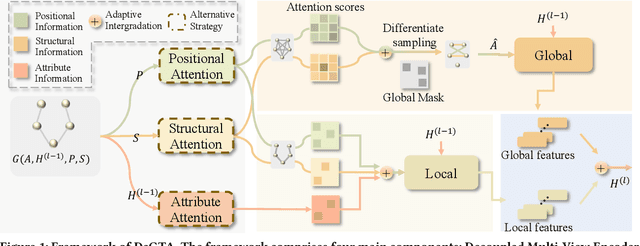
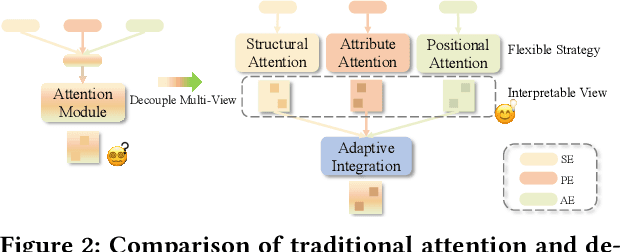
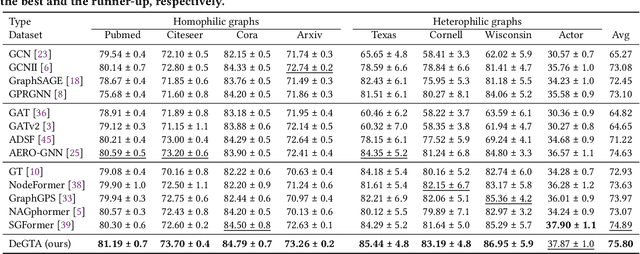
Abstract:Graph Transformers (GTs) have recently achieved significant success in the graph domain by effectively capturing both long-range dependencies and graph inductive biases. However, these methods face two primary challenges: (1) multi-view chaos, which results from coupling multi-view information (positional, structural, attribute), thereby impeding flexible usage and the interpretability of the propagation process. (2) local-global chaos, which arises from coupling local message passing with global attention, leading to issues of overfitting and over-globalizing. To address these challenges, we propose a high-level decoupled perspective of GTs, breaking them down into three components and two interaction levels: positional attention, structural attention, and attribute attention, alongside local and global interaction. Based on this decoupled perspective, we design a decoupled graph triple attention network named DeGTA, which separately computes multi-view attentions and adaptively integrates multi-view local and global information. This approach offers three key advantages: enhanced interpretability, flexible design, and adaptive integration of local and global information. Through extensive experiments, DeGTA achieves state-of-the-art performance across various datasets and tasks, including node classification and graph classification. Comprehensive ablation studies demonstrate that decoupling is essential for improving performance and enhancing interpretability. Our code is available at: https://github.com/wangxiaotang0906/DeGTA
UniGAP: A Universal and Adaptive Graph Upsampling Approach to Mitigate Over-Smoothing in Node Classification Tasks
Jul 28, 2024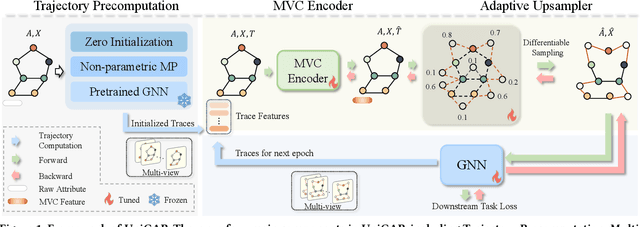



Abstract:In the graph domain, deep graph networks based on Message Passing Neural Networks (MPNNs) or Graph Transformers often cause over-smoothing of node features, limiting their expressive capacity. Many upsampling techniques involving node and edge manipulation have been proposed to mitigate this issue. However, these methods often require extensive manual labor, resulting in suboptimal performance and lacking a universal integration strategy. In this study, we introduce UniGAP, a universal and adaptive graph upsampling technique for graph data. It provides a universal framework for graph upsampling, encompassing most current methods as variants. Moreover, UniGAP serves as a plug-in component that can be seamlessly and adaptively integrated with existing GNNs to enhance performance and mitigate the over-smoothing problem. Through extensive experiments, UniGAP demonstrates significant improvements over heuristic data augmentation methods across various datasets and metrics. We analyze how graph structure evolves with UniGAP, identifying key bottlenecks where over-smoothing occurs, and providing insights into how UniGAP addresses this issue. Lastly, we show the potential of combining UniGAP with large language models (LLMs) to further improve downstream performance. Our code is available at: https://github.com/wangxiaotang0906/UniGAP
BLoB: Bayesian Low-Rank Adaptation by Backpropagation for Large Language Models
Jun 18, 2024
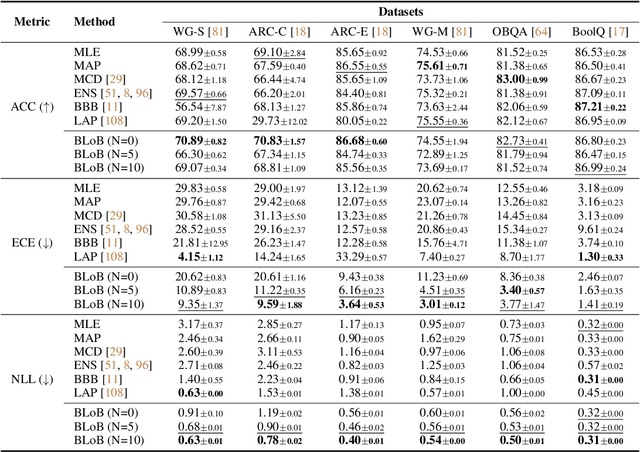
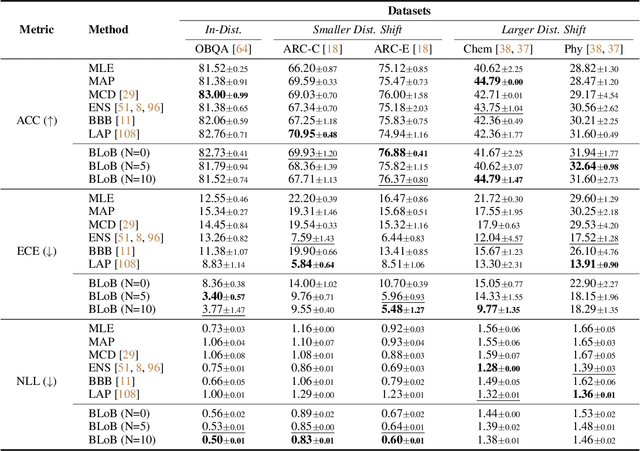
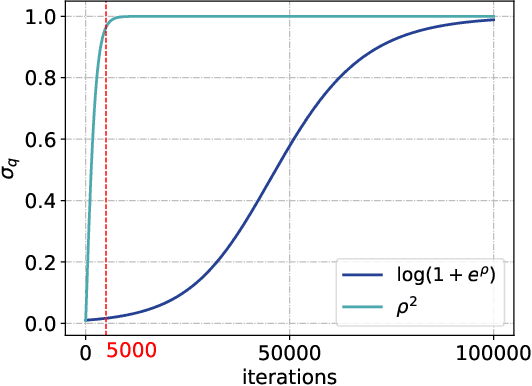
Abstract:Large Language Models (LLMs) often suffer from overconfidence during inference, particularly when adapted to downstream domain-specific tasks with limited data. Previous work addresses this issue by employing approximate Bayesian estimation after the LLMs are trained, enabling them to quantify uncertainty. However, such post-training approaches' performance is severely limited by the parameters learned during training. In this paper, we go beyond post-training Bayesianization and propose Bayesian Low-Rank Adaptation by Backpropagation (BLoB), an algorithm that continuously and jointly adjusts both the mean and covariance of LLM parameters throughout the whole fine-tuning process. Our empirical results verify the effectiveness of BLoB in terms of generalization and uncertainty estimation, when evaluated on both in-distribution and out-of-distribution data.
 Add to Chrome
Add to Chrome Add to Firefox
Add to Firefox Add to Edge
Add to Edge